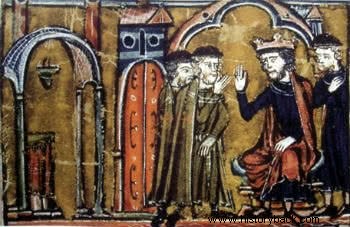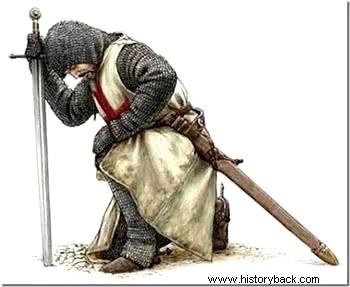The Templars or Order of the Temple was founded in 1128 during the Council of Troyes by Hugo Peyens and Geoffrey de Saint-Omer.
The purpose of the Order was to protect pilgrims who came to Jerusalem. She later took part in battles and built a network of financial aid to European kings, feudal lords and pilgrims.
This power did not please King Philip IV of France, who imprisoned and suppressed the Knights of the Temple in his kingdom.
Origin
The creation of the Order of the Temple falls within the period of the Crusades.
Western Christians had heeded Byzantine Emperor Alexios I Komnenos' appeal to Pope Urban II. The Emperor asked Christians to put aside internal disagreements to fight in the Holy Land and free Jerusalem from the Muslims.
At first, Frankish, British and German soldiers rushed to the battlefield. They sought lands and eternal salvation, just like anyone in the Middle Ages.
Read more about the Crusades.
These knights were monks who knew how to wield weapons. Its founding masters, Hugo de Payens and Geoffrey de Saint-Omer, and the other knights, took the monastic vows of poverty, chastity and obedience. They lived in community and prayer, but they also took part in battles, something forbidden to monks of other orders. In 1128, during the Council of Troyes, in France, they had their rule approved.
The King of Jerusalem, Baldwin II (1118-1131), granted them the Mosque of the Rock for the construction of the convent church. Over time, the mosque became, in the imagination of the crusade, the ancient Temple of Solomon. Therefore, the knights came to be known as Knights of the Temple of Solomon or Templars.

King Baudouin II donates the Mosque of the Rock to Hugo Peyens and Geoffrey de Saint-Omer.
Mission
Once Jerusalem was conquered in 1099 several pilgrims made their way to the holy city. In this way, to protect them, a religious Order was created by nine knights from France and Burgundy. His mission was to ensure security during the crossing between the port of Acre and Jerusalem.
Later they would take part in battles such as the Battle of Montgisar (1177), the Battle of Cresson (1187) and the Siege of Acre (1189-91). All these feuds took place within the framework of the Crusades.
The Order attracted men desirous of reconciling spiritual and military life. Likewise, there was economic growth through inheritances and donations. In this way, the knight-monks began to negotiate loans with the feudal lords and kings of Europe.
They created a banking system similar to what was already practiced in some manors. In London, for example, a pilgrim could leave his money at the Temple Church and then take it back in Jerusalem. For that, a letter with the corresponding credit would suffice.
Thus, the Knights Templar began to be guarantors of properties and to make loans to kings, notably Philip IV, of France. Indebted to the Templars and unable to pay them, the king accused them of heresy.
End of the Templar Order
After the final loss of Jerusalem in 1291, the Knights Templar lost their reason for existing. They meet in Cyprus to elect the new Grand Master of the Order and decide to go back to their religious houses in their respective countries of origin.
At this time, the Templar Order was already part of feudal society and collected taxes from servants and lords, like any normal religious order. Philip IV himself, King of France, borrows from the Knights Templar in order to pay his employees and maintain the army.
Thus, unable to pay his debts, King Felipe IV begins to fear them, as the Order brings together military, economic and religious power in a single organization. He initiates a correspondence with Pope Clement V asking for the suppression of the order.
Then begins the great debate between the two sovereigns. Who would be competent to judge a religious order:the king or the pope? Tired of waiting for Clement V's decision, King Felipe IV ordered the arrest of the Knights Templar and confiscated their goods on October 13, 1307.
The process against the Knights Templar lasts for seven years and in that time, several are tortured and killed. Due to pressure from the French king, Pope Clement V extinguished the Order in 1312. Two years later, Geoffroy de Charnay and Jacques de Molay, the last grand master of the Order of the Temple, are condemned to the stake, marking the end of the Templars.
The knights who managed to escape the tortures and the fire were absorbed by other religious orders, especially the Hospitallers who shared the same ideals.
However, the Order of the Templars survived in Portugal, under the protection of King Dom Diniz under the name of Order of Christ. Some secret societies like the Freemasons also claim to be heirs of the Templars.

A Knight Templar prays after victory in battle.
Curiosities
It was not until 1147 that Pope Eugene III granted the red pateo cross to the Templars. Before, knights wore only a white robe and sergeants a brown robe with a cross sewn on the left shoulder.
A 14th-century legend claims that Jacques de Molay would have cursed King Philip IV and Pope Clement V, summoning them before the heavenly court within a year. The fact is that two died that same year as well.
Read more
Reconquest of the Iberian Peninsula
